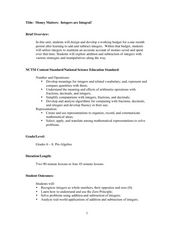Charleston School District
Solving with Inverse Operations
What does order of operations have to do with solving equations? A video explains solving two-step equations using a do/undo chart. Learners recognize the operations within an equation and use inverse operations to undo those...
Curated OER
Weather and Climate
It's hot today, but is that the weather or the climate? This colorful presentation isolates both concepts to allow for better understanding by covering the positioning of the planet, making comparisons of land versus water, and looking...
Spreading Gratitude Rocks
A Note of Gratitude
Gertrude Stein once said, "Silent gratitude isn't much use to anyone." Learners break their silence by engaging in discussion and making lists of what makes them grateful. Next, pupils write and illustrate a thank you letter to a chosen...
West Contra Costa Unified School District
Simplifying Radicals – Day 1
It doesn't get simpler than this. Scholars first learn to simplify radicals by determining the prime factors of the radicand. The lesson progresses to simplifying radicals involving algebraic expressions in the radicand.
Curated OER
Summer Shorts
Want to use sequence maps in your narrative writing unit? Young writers work to create personal narratives about their summer vacation. They write a narrative of their vacation and create a display using summer clothing shapes made from...
Curated OER
Positive/Negative Bugs
Bugs can be creepy - and fun! Kids create a positive and negative design by repeatedly drawing a simple insect overlaid with a geometric shape. The outcome is really neat and will help build spacial reasoning, visual acuteness,...
Curated OER
Angles, Lines, and Transversals
Geometers identify and determine angle pair relationships when two parallel lines are intersected by a transversal. They review the concepts of angles by watching streaming video clips online, read definitions of lines and angles from...
Curated OER
Chopping Cubes
Middle schoolers work in small groups to make various geometric solids with Play-Doh. They use fishing line to make cuts and observe the shapes of the cross-sections. Pupils complete an assessment in which they answer questions such as:...
Curated OER
Investigating Newton's Second Law Of Motion
Students participate in a lesson that investigates Newton's Second Law of Motion. They conduct an experiment of observing balls that are rolled down a ramp. The lesson includes background information for the teacher for preparation and...
Curated OER
Organic Chemistry II Review Questions
In this chemistry worksheet, students determine the order of reactivity toward displacement in each of the series listed. Then they respond to several multiple choice questions as they relate to compounds and solutions. Students also...
Curated OER
Comma Exercise: Exercise 1
In an exercise from the Purdue Online Writing Lab, learners can review 11 rules for comma usage. They then either label 21 sample sentences C for correct as is, or they identify which rule of comma usage is being broken. Though the...
Curated OER
Number Addition Race
Practice basic addition facts and measuring skills. In this addition and measurement lesson, students are provided with drywall tape and work in groups of four at a long table. Partners take turns generating addends and marking the...
Curated OER
Geometric Properties
High schoolers find triangular angles using the angle theorem. In this geometry instructional activity, students describe labeled triangles, use the pythagorean theorem, and rewrite information about triangles in standard form.
Math Doctor
Chapter 2: Integers & the Number Line
Here is an extensive set of teacher's notes to help you teach all about integers. Begin by introducing a number line and how it can be used to visualize positive and negative numbers. Talk about absolute value and the additive inverse...
National Security Agency
Ordering, Adding and Subtracting Integers
Prealgebrarians use colored chips, stickers, and pencils to explore the world of integers. They discover absolute value, compare positive and negative integers, and apply operations to them. A detailed procedure for the three-part...
National Security Agency
Money Maters: Integers are Integral!
A thoroughly-written lesson plan and a plethora of worksheets about integers comprise this resource. Neophyte number crunchers learn to recognize integers, add and subtract them, and apply the concepts to the designing of a personal...
Curated OER
Italian Fascism
By first defining the characteristics and ideology of fascism, this presentation makes it easy for viewers to contextualize the rise of Mussolini in post-WWI Italy. Not only thorough and informative, the pictures and concepts featured in...
Curated OER
Peace Brainstorming Activity
Students study the topic of peace and use brainstorming techniques to create a clustering diagram. In this peace brainstorming activity, students organize brainstorming material to complete a writing assignment. Students create...
Curated OER
Introduction to Magnets
Ask your class what they know about magnets, then take some time and explain basic magnetic properties. This presentation covers polarity, magnets in compasses, and magnetic force. It provides a quick hands-on exploration where kids...
Novelinks
Touching Spirit Bear: The Literary Mandala
Even someone with a dark side can make a good decision—and vice versa. Readers explore Cole's traits and decisions in Ben Mikaelson's Touching Spirit Bear and analyze his sunside and...
Curated OER
Boccia
Boccia is very similar to the game of bocce. There is a jack, a small ball that is tossed within a 12' x 6' area which becomes the target. Each team has six hand-sized leather balls which they try to get as close as possible to the jack...
Curated OER
Lincoln is in the House! ("Name-Dropping" Poems and the Power of Connotation)
“What’s in a name?” Just about everything. Barack Obama, Vincent van Gogh, Justin Bieber. Famous names evoke a multitude of reactions and poets often use the names of famous people in their works precisely because names carry...
Student Handouts
Letter from Christopher Columbus to Luis de Sant Angel Announcing His Discovery (1493)
When Christopher Columbus landed, he found many things to comment on. Have your class read this letter that he wrote to Luis de Sant Angel in 1493. The text is split up into sections. Each section is paired with two to three...
Tutankhamun
Pharaohs, Pyramids and the World of the Gods
Your young historians will learn all about the pharaohs, pyramids, and gods of ancient Egypt with these informational text worksheets, each of which are accompanied by hands-on, follow-up activities.























